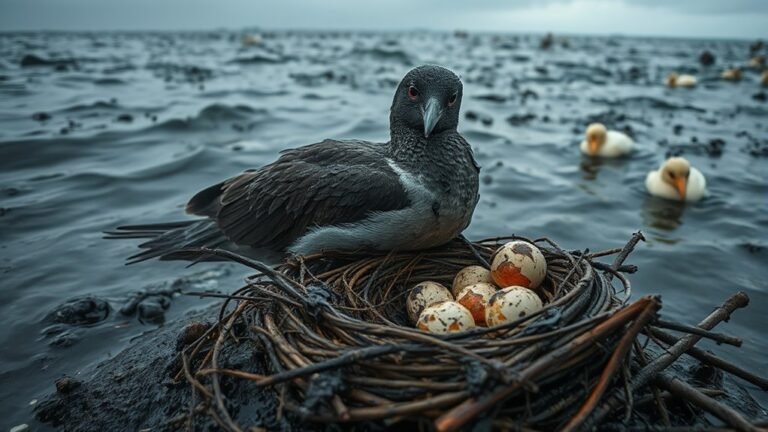The Story of Mike the Headless Chicken
You may think that losing his head would be the end for Mike the Headless Chicken, but he surprised everyone by living for 18 months after decapitation. How did this happen? Some unique biological factors helped him survive. As you learn about Mike's story, you will see more than just a strange occurrence—it's also a story about resilience, care, and the ethics of how we treat animals. What lessons does Mike's story offer us?
Key Takeaways
- Mike the Headless Chicken survived for 18 months after losing his head in 1945, becoming a symbol of resilience.
- His brain tissue remained intact, allowing basic functions and circulatory processes to continue without major disruption.
- Local media coverage boosted Mike's fame, transforming him into a national attraction and generating financial gains for his owner.
- A specialized diet, routine care, and human intervention were crucial to maintaining Mike's health during his unusual life.
- Mike's legacy raises important ethical questions about animal treatment and challenges perceptions of entertainment involving animals.
The Unfortunate Incident: How Mike Lost His Head

When you hear the strange story of Mike the Headless Chicken, it's hard to imagine that a simple chicken could become a symbol of survival.
This incident took place in 1945 when farmer Lloyd Olsen planned to prepare Mike for dinner. During this process, Mike lost his head, but instead of dying, he surprisingly continued to live.
Astonishingly, Mike lived for 18 months without his head! This situation puzzled many, raising questions about how a headless chicken could survive.
News spread and Mike became a local attraction, drawing crowds and winning hearts. He became an unexpected symbol of resilience, reminding us that life can continue in the most surprising ways.
Surviving Against the Odds: The Science Behind Mike's Longevity
Mike the Headless Chicken's remarkable survival is due to a mix of biological factors and unique circumstances. His case provides interesting insights into neurobiology, prompting reflection on life and resilience.
Consider these factors that contributed to Mike's long life:
- Specific brain tissue: This tissue is important for essential functions.
- Blood supply: The circulatory system managed to keep working without major disruption.
- Adaptability: This chicken showed exceptional resilience, a trait studied by biologists.
- Supportive environment: His surroundings helped promote his well-being.
- Care from owners: Human intervention played a key role in ensuring his survival.
These studies on resilience demonstrate that even unlikely creatures can adapt and thrive. Mike's story encourages us to find hidden strengths in our own challenges.
The Role of the Brain and Nervous System in Mike's Survival

Mike's survival was remarkable. It was due to his biological makeup and the functions of his brain and nervous system. Even without his head, his brain allowed him to keep reflexes and basic motor skills.
The remaining brain parts took care of vital body functions. This enabled him to walk, perch, and eat. His nervous system actively sent signals through his body. This process helped him respond to his surroundings.
Observers were amazed by Mike's ability to survive in such an unusual state. His story highlights the vital roles that brain function and the nervous system play in survival and adaptation.
Mike's experience draws attention to the fascinating world of avian biology and resilience.
The Farmer's Decision: From Tragedy to Peculiar Fame
After the shocking event with Mike, farmer Lloyd Olsen faced a tough choice. Should he get rid of Mike or show him off? He decided to showcase Mike, turning a disaster into a unique opportunity for fame.
Here's what happened next:
- Mike drew many curious visitors.
- Local media shared his strange story.
- Lloyd sold merchandise related to Mike.
- The spectacle grew into national fame.
- The fame brought mixed public reactions.
Although the attention brought money, it also added pressure on Lloyd.
This story shows how life can change in surprising ways.
Mike's Unusual Diet and Care Routine

As the attention on Mike increased, his owners changed how they fed him.
They created a special diet using grains and supplements to meet his nutritional needs.
His care routine also changed to support his health.
His owners watched him closely and kept his living space clean and comfortable.
They even made a simple water dispenser to ensure he stayed hydrated.
Touring America: The Rise of a Celebrity Chicken
Once Mike the chicken became famous, he gained attention across America. His story captivated many, and the idea of a headless chicken amazed people. He toured fairs and carnivals, and crowds gathered to see him.
As Mike traveled, the interest in novelty chickens grew throughout the country.
Here's what you'd learn about his rise to fame:
- Unique attractions and difficulties of touring
- Marketing strategies that contributed to Mike's fame
- Public reactions and increasing fan base
- Connections with other famous animals
- Media coverage that boosted his popularity
Mike was more than just a chicken; he became an unforgettable symbol in America.
Public Fascination: The Cultural Impact of Mike the Headless Chicken
Mike the Headless Chicken became a famous symbol of resilience. His unusual story sparked interest and conversation among many people.
You might wonder how a headless chicken captured such attention. Mike's journey encouraged discussions about survival and overcoming challenges. His tale resonated with people, fostering a sense of curiosity and empathy.
Mike's story is similar to today's viral stories, showing how oddities connect diverse groups.
His impact goes beyond being just a headless chicken; it reflects shared human experiences and our ability to find meaning in the unexpected.
The Legacy of Mike: Lessons Learned From His Life
Mike the Headless Chicken's story teaches important lessons about adaptability and perseverance.
His journey shows that unexpected situations can lead to resilience and even fame. Here are the key lessons from Mike's legacy:
- Embrace change, even if it feels scary.
- Keep going, as perseverance can bring success.
- Community support is vital in difficult times.
- Approach challenges with creativity.
- Small beings can make a big difference.
Mike's legacy inspires you to rise above challenges and find your place in life.
His surprising fame urges you to carve your own path, proving that greatness can come from the most unexpected places.
Other Notable Animals With Extraordinary Survival Stories
Animals have shown remarkable resilience and adaptability throughout history, much like Mike the Headless Chicken.
Take Hachiko, the loyal Akita who waited nine years at a train station for his deceased owner. His loyalty became a symbol of love.
Another example is Stubby, a war dog who served in World War I. He saved soldiers and became the first dog to earn a rank in the U.S. Army.
These pets demonstrate strong survival instincts, not only in their own challenges but also in their bonds with humans.
Their stories remind us of the powerful connections between species that lead to acts of bravery and love. This is certainly worth celebrating.
The Ethics of Animal Treatment: Reflecting on Mike's Life
Mike the Headless Chicken's amazing story raises important questions about how we treat animals and what this means for their welfare.
Here are key points to consider:
- We must prioritize animal ethics.
- The treatment of one animal reflects broader issues.
- Society should support humane treatment for all animals.
- Understanding animal welfare is crucial for ethical practices.
- Increasing awareness can promote positive changes in animal treatment.
Mike's Final Days: How a Headless Chicken Came to an End
Mike the headless chicken lived for 18 months, which amazed many people.
However, his final days tell a sad truth. As we look at how Mike spent his last moments, we must think about the ethics of his care. Mike struggled to survive, but his health declined over time.
The people who looked after him had to make a tough choice: to keep him alive in pain or to let him go peacefully. They chose kindness.
Though Mike's story was unusual, it raises important questions about how we treat animals and the limits we should consider for entertainment.
In his last days, Mike reminded us to think about the ethics of our connections with animals.
Frequently Asked Questions
How Did the Farmer Care for Mike Without a Head?
To care for a headless chicken, the farmer used a dropper to feed it directly. He ensured the chicken had a safe and comfortable place to live. This approach helped the unique chicken to stay healthy and strong. The farmer's attention to its needs made a difference in its well-being. By providing proper care, the farmer allowed the chicken to thrive despite its unusual condition.
What Happened to Mike's Owner After His Fame?
After gaining fame, the farmer faced challenges from the sudden attention. He worked hard to keep his legacy intact. While he enjoyed being in the spotlight, the pressures and expectations often took away the joy from his remarkable creation. He found it difficult to balance public interest with his daily life.
How Did Mike Avoid Predators Without Proper Vision?
Mike lacked proper vision, but he adapted effectively. He became more aware of his surroundings and heightened his senses. This change helped him detect nearby threats. Nature helps animals survive by adjusting to their challenges, and Mike's experience shows this ability in action.
What Were Common Misconceptions About Mike's Survival?
Many people believe that Mike's survival depended on special powers. However, this belief misses an important detail: his medical differences. Mike's body worked in unusual ways that helped him survive. His story combines real life and legend, showcasing his strong spirit and will to live.
How Did Mike's Story Influence Animal Welfare Discussions?
Mike's story started important conversations about animal rights. It raised awareness of animal welfare issues. The story prompted many people to think about farming practices. This encouraged discussions about the need for better living conditions for animals. As a result, a community grew that cares about animal welfare.

Hello, I’m Emily Price, the founder of Birds Affection. As a passionate bird enthusiast and spiritual seeker, I’ve always been fascinated by the symbolic meanings and mystical connections between birds and our lives. On this website, I share my knowledge and insights on the spiritual significance of various bird species, exploring their roles as messengers, guides, and teachers. Through my writing, I aim to inspire and educate others on the profound wisdom and beauty that birds bring to our world. Join me on this journey as we delve into the enchanting realm of bird symbolism and discover the hidden meanings behind these magnificent creatures.







